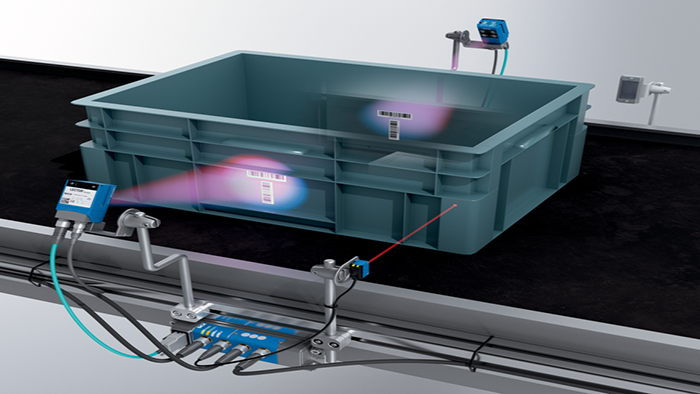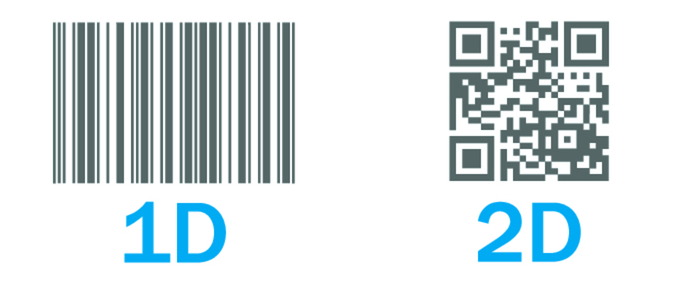1D barcodes - i.e. one-dimensional barcodes - refer to simple barcodes, whereas 2D barcodes - i.e. two-dimensional barcodes - are usually square codes with a black and white pattern.
Barcode Scanner - 1D Barcode vs. 2D Barcode - the differences, advantages and possible applications
History of the barcodes
In terms of history, the 1D barcode is definitely ahead of the game - the first attempts with this barcode technology were made as early as 1949. In 1974, products in the food trade began to be marked with barcodes, establishing the 1D code as the standard. This barcode technology has continued to develop unstoppably and is still indispensable in today's industry. At the end of the 80s, the 2D barcode was introduced, which at that time was mainly used in industrial environments. Today, this is no longer the case - 2D codes are also very common in the private sector. For example, by scanning a QR code with a smartphone, information on products, competitions, etc. can be retrieved.
If we look at barcode technology in the industrial sector, it is primarily aimed at the traceability of products and the control of processes. Product labeling makes it possible to trace the material flow throughout the entire production process, and it is known at all times where the product is currently located, when it was processed, and much more.
When we talk about 1D barcodes, we are mainly talking about labels that are applied to the product. However, direct marking is also possible, e.g. by direct printing on cardboard boxes. The development of 2D matrix codes as well as the rapid increase in performance in image processing allowed the application of new, label-free direct marking methods, such as needle embossing, laser marking or inkjet, i.e.: Direct Part Marking (DPM). Compared to labels, DPM can withstand the most adverse production or operating processes and environmental influences, and also prevents product piracy. This opens up new possibilities for the user in the traceability of individual components or assemblies, as they are almost indestructible, permanently marked and identifiable.
Laser-based barcode scanner
In the field of 1D barcode reading, so-called laser scanners are used. Laser scanners exclusively read 1D codes, whereby they also detect damaged or polluted codes thanks to sophisticated algorithms. Depending on the arrangement of the barcode elements, parallel (ladder orientation), orthogonal (garden fence orientation) or omnidirectional (no orientation 360°) line scanners, raster scanners or oscillating mirror scanners are used. Laser-based scanners use a laser diode to scan the barcode label and detect the intensity of the laser light reflected from the light and dark elements of the barcode. This requires that a good barcode contrast is given.
- excellent depth of field
- large reading field width
- insensitivity to extraneous light sources
- no additional illumination necessary
- trouble-free code reading during object standstill and acceleration
- low costs
Possible applications of laser-based barcode scanners:
Laser scanners have an excellent depth of field and are therefore able to identify barcodes on objects of different heights without any problems. Due to the large fields of view of up to 60°, one device already covers most conveyor belt widths. For this reason, laser scanners are ideally suited for use in courier, express and parcel services or in warehousing and materials handling, among other applications.
More details about laser-based barcode scanners.
Camera-based barcode scanner
If the rotational position of a code in a plane is not exactly defined and is variable in the application, a single camera-based code reader can reliably detect all codes regardless of their rotational position. This advantage becomes particularly clear in the case of codes with short bar lengths, since here a laser-based solution cannot achieve identically good read rates as the camera-based reader, even with two readers. In applications with poor code quality, for example due to weak contrasts or partial destruction, camera-based code readers achieve reliable reading results due to the corrective image processing algorithms. This reduces the need for manual postprocessing.
The benefits of camera-based barcode scanner:
- Flexibility of code reading (1D, 2D and plain text)
- Live image and image storage for analysis or data archiving
- Omnidirectional reading with only one device
- Reading of poor code qualities
- Use of widely varying module sizes
More details on camera-based barcode scanners.
Conclusio
Camera-based code readers are characterized by their flexibility in selecting the code type. In addition to 1D barcodes, they identify both plain text and 2D codes such as the frequently used Data Matrix, QR (see Figure 2) or Maxi Codes via various image processing algorithms. A change from 1D barcodes to 2D barcodes can thus be made without any problems.
There is a trend from camera-based to laser-based barcode reading, but due to the wide range of applications, none of the identification technologies is suitable for all applications. The optimum technology for a particular application is the one with the best cost-benefit ratio in the individual area of conflict between technical and economic requirements.
Find the right identification solution
What reading properties do you need? Will a 1D or 2D barcode be read? In what form should data be analyzed? Use our identification explorer, select the criteria of your very specific application and find the right identification solution.
I would like to keep up-to-date and be informed of new articles on a regular basis!






